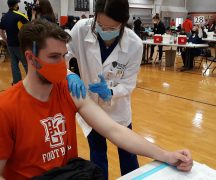By DAVID DUPONT
BG Independent News
Heading into the second full semester of the pandemic, President Rodney Rogers says he’s more optimistic now.
Classes began Monday at Bowling Green State University.
“I’m more confident right now than perhaps I was in the fall,” Rogers said Monday in a telephone interview. “I think the difference right now is we have testing capabilities that we did not have at the beginning of fall term.”
The university now has “access to significant rapid testing as well as the lab the hospital has for the PCR,” Rogers said. “In both cases we have the ability to quickly test individuals and get a result. That’s a game changer for us. That was something we were all trying to figure out. How do we have the testing capability to have the level of testing we wanted? Now we’re feeling pretty good that we have a handle on that situation.”
The university also has set the system for quarantining students who have been exposed to the virus, and isolating those who test positive.
Rogers added: “I’m so proud of our students. They have demonstrated a level of maturity and commitment to the community to make this work. I believe we’re in a solid position to find a way forward.”
Students were tested for the virus when they moved back into off-campus housing after the extended break. Residential students were sent at-home testing kits to use before is they returned to campus.
The numbers, Rogers said, are lower than the state’s COVID-19 numbers.
Rogers also said that enrollment is down. As in fall, graduate enrollment is holding up, but undergraduate enrollment has dipped. That decline is “modest,” he said, compared to some of BGSU’s peer institutions. “Those numbers will settle out as we get further into the term.”
Again, the university will offer instruction in various modes.
Rogers said that according to Provost Joe Whitehead the mix is largely the same, except now something over 10 percent of the courses will be in-person. That’s an increase from fall.
Those courses have small class sizes – sciences courses that require lab work and arts courses that require studio instruction.
There remain a number of hybrid courses where instruction is provided both in person and remotely. About a quarter of the classes will be completely remote with students attending virtually at the specified class times, and another quarter will be online, where the class is recorded and students can access it at their convenience.
The university has offered faculty professional development opportunities to better address online learning, and faculty are developing new approaches. “They continue to innovate as they deliver a safe educational experience for our students,” Rogers said.
Student affairs personnel have been working on social programming to help students meet each other. “We want to find ways that students can make connections in small groups in safe way,” Rogers said.
Programs will be presented outside, even though it’s winter. “I hope they brought their parkas.”
Parkas or no, the students seem to be happy to be back on campus after being away since before Thanksgiving, Rogers said. “And we’re happy to have them back.”





